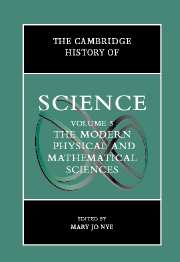Book contents
- Frontmatter
- Introduction: The Modern Physical and Mathematical Sciences
- Part I The Public Cultures of the Physical Sciences After 1800
- Part II Discipline Building in the Sciences: Places, Instruments, Communication
- 6 Mathematical Schools, Communities, and Networks
- 7 The Industry, Research, and Education Nexus
- 8 Remaking Astronomy: Instruments and Practice in the Nineteenth and Twentieth Centuries
- 9 Languages in Chemistry
- 10 Imagery And Representation In Twentieth-Century Physics
- Part III Chemistry and Physics: Problems Through the Early 1900s
- Part IV Atomic and Molecular Sciences in the Twentieth Century
- Part V Mathematics, Astronomy, and Cosmology Since the Eighteenth Century
- Part VI Problems and Promises at the End of the Twentieth Century
- Index
- References
8 - Remaking Astronomy: Instruments and Practice in the Nineteenth and Twentieth Centuries
from Part II - Discipline Building in the Sciences: Places, Instruments, Communication
Published online by Cambridge University Press: 28 March 2008
- Frontmatter
- Introduction: The Modern Physical and Mathematical Sciences
- Part I The Public Cultures of the Physical Sciences After 1800
- Part II Discipline Building in the Sciences: Places, Instruments, Communication
- 6 Mathematical Schools, Communities, and Networks
- 7 The Industry, Research, and Education Nexus
- 8 Remaking Astronomy: Instruments and Practice in the Nineteenth and Twentieth Centuries
- 9 Languages in Chemistry
- 10 Imagery And Representation In Twentieth-Century Physics
- Part III Chemistry and Physics: Problems Through the Early 1900s
- Part IV Atomic and Molecular Sciences in the Twentieth Century
- Part V Mathematics, Astronomy, and Cosmology Since the Eighteenth Century
- Part VI Problems and Promises at the End of the Twentieth Century
- Index
- References
Summary
In the years between 1800 and the end of the twentieth century, astronomy was fundamentally transformed. That which had been at heart a science of position, in which astronomers strove to say where an object is, not what it is, became in many ways a vastly more wide-ranging and large-scale enterprise in terms of the questions asked of nature, the number of astronomers it engaged, the level of public and private support it enjoyed, and the size and sophistication of the instruments employed, as well as the remarkable extension of observations beyond the narrow window of optical wavelengths.
The focus of this chapter is on those changes in observational astronomy that comprised central elements in this remaking of astronomy between 1800 and 2000: the reform of positional astronomy in the early nineteenth century, the rise of astrophysics (although little attention is devoted to the study of the Sun, as that is discussed elsewhere in this volume), and the ways in which shifting forms of patronage provided new opportunities for state-of-the-art instruments. In all of these areas, the history of the telescope, the key instrument in observational astronomy in the last four centuries, will be key. We shall also see that the improvement of telescopes was often not tied to answering particular theoretical questions, but was rather seen as a worthy goal in itself that would, in turn, lead to novel results. It should be noted, too, that we are concerned with astronomy in the Western world at the cutting edge of research. I shall therefore not address very interesting questions about the development of instruments for use primarily in demonstrations (e.g., planetaria) or employed chiefly for recreational uses.
- Type
- Chapter
- Information
- The Cambridge History of Science , pp. 154 - 173Publisher: Cambridge University PressPrint publication year: 2002
References
- 1
- Cited by

